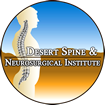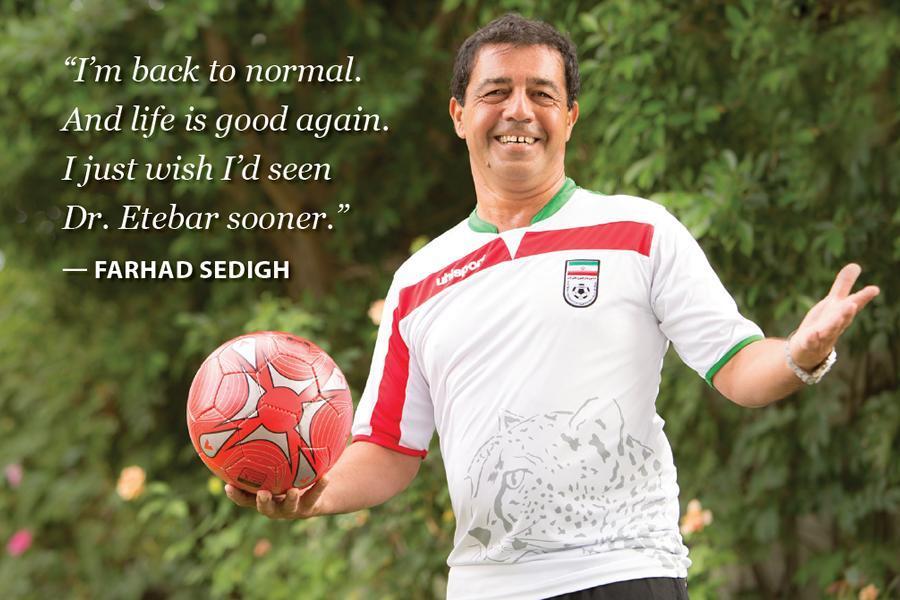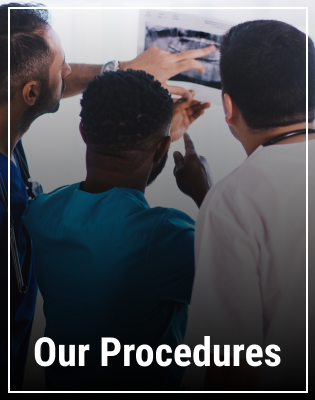Neurosurgeon Ends Patient’s Debilitating Pain
Farhad Sedigh, 54, had been active throughout his life. “I played sports in high school and college,” the Rancho Mirage resident relates, “and I always hiked, and played golf, racquetball and soccer.”
But all that “dropped off” when he started experiencing sciatica about four years ago. Sciatica is pain that radiates along the sciatic nerve, which branches from the lower back through the hips and buttocks and down each leg. This type of pain usually results from a herniated disk or narrowing of the spine (stenosis) that compresses part of the nerve.
“It was slowly hindering my movement to the point where I couldn’t walk across the street or move without grimacing or making grunting noises,” Sedigh says. He recalls visiting a large outdoor museum in Berlin, Germany with his sister-in-law where, “I sat on every single bench in the area because I just couldn’t walk, it hurt so much.”
Sedigh even ended up cracking two teeth because the pain caused him to clench his jaw so tightly when he slept.
The terrible effects of pain
“You learn to improvise and adapt, to limit yourself and bite the bullet, if you will,” he says. “But pain changes your psyche. It demoralizes you and breaks you down slowly.
“And it affects the people around you,” he adds. “Your daughters see their father in pain, your wife sees her husband in pain, and they feel helpless. It changes the whole dynamic of your life.”
Sedigh endured the worsening pain for two years, seeking relief through conservative measures like chiropractic treatments, physical therapy and therapeutic massage.
He also saw a pain management specialist who offered pain medication and gave him a series of corticosteroid injections.
“I’m really not a pain medication person and narcotics don’t sit well with me,” Sedigh says. “When it became apparent that the shots weren’t going to do it either, the doctor said it was time for me to see a neurosurgeon.”
Resistant to surgery
Sedigh admits he’d resisted the idea of surgery.
“Everyone was saying ‘don’t go to a surgeon,’” he says. “But then my doctor said I can listen to them or I can listen to what a neurosurgeon has to say.”
Sedigh opted to meet with several neurosurgeons and orthopedic surgeons.
“I wanted to get different opinions about how they’d handle my case and what to expect after surgery,” he explains. “Dr. Etebar was the first surgeon I was referred to, and the one I came back to about performing my surgery.”
Shahin Etebar, MD, is a Board Certified Neurosurgeon with advanced fellowship training in reconstructive spinal surgery.
Surgery tailored to the individual patient
“Dr. Etebar’s clarity and professionalism were impressive,” Sedigh continues. “He asked about my background, my lifestyle, level of activity and my education. I have an engineering degree, and he explained the surgery he’d perform in a way I understood. He chose a procedure that was tailor-made for my case.”
“The key thing is matching the right treatment to the right pathology to the right patient,” says Dr. Etebar. “Mr. Sedigh is young and very athletic, and part of the goal was to treat him so he could return to his activities and be able to function long-term. His diagnosis was spondylolisthesis (where one vertebrae slips over another one) and stenosis of the spinal canal.”
The procedure that Dr. Etebar recommended for Sedigh was spinal decompression and fusion of two of his lumbar (lower back) vertebrae with instrumentation. Decompression entails removing a small portion of the bone over the nerve root to relieve pressure and the pinching of the spinal nerves. The affected vertebrae are then fused together to ensure stability.
“The other surgeons I talked to just wanted to do the decompression,” Sedigh notes. “Dr. Etebar explained that I already had some instability and after the decompression would have more, so that’s why he was recommending the fusion.”
Sedigh underwent surgery at Eisenhower Medical Center in September 2013. He was in the hospital for two nights, and was up walking the morning after his procedure. In less than a week, he returned to work at the car dealership he owns.
The pain stopped “instantly”
“The pain stopped instantly,” says Sedigh. “As soon as Dr. Etebar removed the bone, part of the joint and ligaments that were pinching the nerve, my nervous system could flow freely.
“He gave me exercises and guidelines to follow after surgery, to strengthen the muscles around where the incision was,” Sedigh notes. “I had to change some of my movements, how I would bend, turn and twist. I had to remember to lift with my legs and use my stomach muscles. And I would tread water in our pool every day.”
Dr. Etebar also recommended that his patient stay off the golf course for six months after surgery, to give the fusion time to heal.
The importance of after-care
Sedigh complied with his after-care guidelines and today, two years after his procedure, he has resumed his active lifestyle — and then some.
“I play soccer two days a week,” he says. “I regularly hike an 11,000-foot mountain with the highest elevation gain per mile in the country. And I’m playing golf and racquetball.”
“It is very rewarding to see patients who do this well and can return to what they love to do,” says Dr. Etebar.
“I’m back to normal,” adds Sedigh. “And life is good again. I just wish I’d seen Dr. Etebar sooner.”


